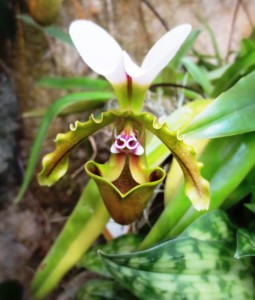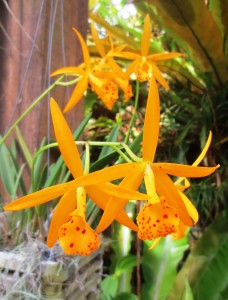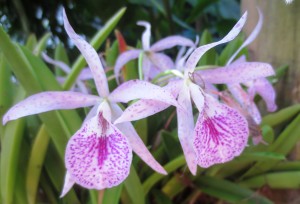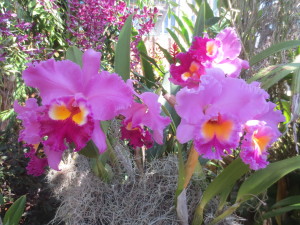By Lesley Fleming, HTR, and Jeanne Willis, with Susan Morgan
Photos by L. Fleming
When a man falls in love with orchids, he’ll do anything to possess the one he wants. It’s like chasing a green-eyed woman or taking cocaine…it’s sort of madness…
Norman Mac Donald, The Orchid Hunter, 1939
Orchids attract passion and mystery. What is it that stirs the hysteria for these intriguing plants? Check out this interesting list of orchid facts.

There are more than 25,000 documented species of orchids, making the Orchidaceae family one of the largest families of flowering plants (Kramer, 2013). (Learn how to pronounce Orchidaceae here.)
The word orchis is derived from the Greek word meaning “testicle,” referring to the shape of bulbous roots found in some orchid genera (Flowerweb).
The term orchid, as a shortened version of Orchidaceae, was not introduced until 1845 (Flowerweb).
Many scientists suspect that hybridized orchids would not occur in nature and that there are more species yet undiscovered, especially in tropical areas (Kramer, 2013).
The smallest orchid is believed to be Platystele jungermannioides at 2mm in size (Flowerweb). (Read more about the world’s smallest orchid here.)
Some orchid species can survive up to 100 years (Flowerweb).

Botanists studied “one thousand wild orchids for fifteen years and during that time only twenty-three were pollinated.” Some orchid seedpods are filled with millions of tiny dust-sized seeds (Orlean, 1998).
The world’s first orchid book Orchid Guide for Kuei-men and Chang-chou, written by Chao Shih-ken, was published in 1228 in China (Orlean, 1998).
During the Ming dynasty, orchids were used to treat a range of health issues, including diarrhea, venereal diseases, neuralgia, and sick elephants (Orlean, 1998).
A record setting two-ton Grammatophyllum speciosum orchid was displayed at the first world’s fair – the 1850-1 Crystal Palace Exhibition in London, England (Orlean, 1998). (Read more about this large orchid here.)

Orchids have symmetry similar to a human face. Scientists think that the orchid’s symmetry is one of the reasons for human fondness for this plant (Kramer, 2013). (Read more about the bilateral symmetry of orchid flowers here.)

Victorian women were forbidden from owning orchids because the flower shapes were considered to be sexually suggestive (Orlean, 1998).
Suffragettes destroyed several orchid specimens at Kew Gardens in London, England, in 1912(3) (Orlean, 1998). (Read more about the Kew Orchid House attack here.)
Vanilla, the popular flavor and fragrance is extracted from the pod of Vanilla planifolia, a species of orchid (Flowerweb). (Read more about the Vanilla orchid here.)
The Florida connection to orchids began in 1874, when it is reported that avid gardener Jane Kenniburgh moved from Carickfergus, Ireland, to Tallahassee, Florida, with her Phaius grandifolius orchid, often referred to as nun’s lily. This orchid was recognized as the first greenhouse-cultivated orchid in Florida (Orlean, 1998).
Some orchids are considered to resemble creatures from the animal kingdom, like the bee orchid (Ophrys apifera). It lures the males of a certain species of bee because of its appearance and enticing smell (Dearringer). (Read more about the fascinating bee orchid here or watch a video about it here.)
The orchid Dendrophylax lindenii, also known as the ghost orchid, grows wild in Florida and is considered to be one of the most sought after specimens (Orlean, 1998). (Read more about the ghost orchid here.)
Orchids in this article were photographed at Marie Selby Botanical Gardens in Sarasota, Florida.
Resources
Dearringer, M. (no date). Seven Little Known Orchid Facts. Retrieved Dec. 4, 2015 from http://www.orchidplantcare.info/a-few-fun-facts-you-might-not-know-about-orchid-plants/.
Flowerweb (no date). 15 Amazing Facts About Orchids. Retrieved Dec. 4, 2015 from http://www.flowerweb.com/en/article/190242/15-Amazing-Facts-About-Orchids.
Kramer, M. (2013). 5 Surprising Facts About Orchids. Retrieved Dec. 4, 2015 from http://www.livescience.com/28547-surprising-orchid-facts.html.
Orlean, S. (1998). The Orchid Thief. New York: Random House.


Such an interesting article! Interesting to consider the symmetrical relationship between us! Loved the historical facts especially how early they were identified in ancient China and the male symbolization causing an attack by the suffragettes. An Orchid is “not just a pretty face”.